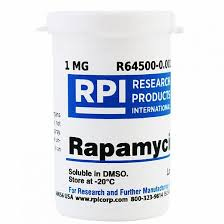Longevity - Rapamycin
Hype, Hope, and Hard Truths
Longevity Series: Rapamycin – Hype, Hope, and Hard Truths
We’re starting a new series here on Substack: The Longevity Series. Each installment will look at one of the “buzziest,” most controversial, or most promising ideas in aging science. We’ll separate what’s real from what’s risky—and shine a light on the myths that make their way into social feeds and supplement ads.
Let’s begin with one of the biggest names in longevity research: rapamycin.
🌱 From Easter Island to the Fountain of Youth?
Rapamycin was first discovered in soil samples from Easter Island (Rapa Nui). Originally developed as an antifungal, it became a powerful immunosuppressant—so powerful that it’s FDA-approved to prevent organ rejection and treat certain cancers.
But in the last 15 years, rapamycin has made headlines for a different reason: it extends lifespan in multiple species.
Yeast, worms, and flies all lived longer when given rapamycin.
In genetically diverse mice, both males and females showed extended median and maximum lifespan—even when treatment started late in life.
Mechanistically, rapamycin inhibits the mTORC1 pathway. This slows cellular aging, promotes autophagy (cellular cleanup), and delays age-related diseases like cancer.
That’s the promise. But what about humans?
👩⚕️ Human Evidence: Still Early Days
Here’s what the data show so far:
Clinical trials in older adults (65+): Some studies report improved immune response to vaccines and modest benefits in physical function and well-being.
Off-label users: Surveys of hundreds of healthy adults self-administering rapamycin off-label suggest low-dose, intermittent regimens are generally well tolerated.
Hard endpoints: No trial has shown that rapamycin extends lifespan or healthspan in humans. So far, we only have short-term surrogate markers like immune function and lean tissue changes.
In other words: in people, the “fountain of youth” claim is still unproven.
⚠️ The Side-Effect Profile
Rapamycin is not a free ride. Even at low doses, studies report:
Mouth ulcers (stomatitis)
Skin rashes
GI upset (nausea, diarrhea)
Changes in glucose metabolism, sometimes leading to insulin resistance
Mild anemia and lipid increases
Increased risk of infections, especially at higher or chronic doses
While many of these effects are dose-dependent and often reversible, the fact remains: rapamycin is still a potent immunosuppressant. That’s why its FDA approvals are limited to transplants and cancer—not healthy aging.
📖 The Attia Effect
In his popular book Outlive, Peter Attia describes rapamycin and related therapies in ways that make them sound almost like a win–win: a pill that hacks biology to extend health and vitality. And while the enthusiasm is understandable—we all want a fountain of youth—this framing risks glossing over the trade-offs.
Because here’s the hard truth: healthspan doesn’t mean living longer with side effects of a drug. Healthspan is about more years of vitality, mobility, and independence—not ulcers, rashes, or impaired glucose control.
🧾 The Current Consensus
The medical literature is clear:
Rapamycin consistently extends lifespan and healthspan in animal models via mTOR inhibition.
Human evidence is preliminary—promising, but far from proving lifespan extension.
More randomized, long-term trials are needed before anyone can responsibly claim rapamycin slows aging in people.
🥗 Why I’ll Stick With the Mediterranean Diet (for Now)
I’ve been known as “Mr Mediterranean,” but there are many reasons why. And the Mediterranean Diet isn’t just what they eat in the Mediterranean.
It’s tempting to reach for a pill that seems to mimic longevity in animals. But until human data catch up, rapamycin remains experimental. Meanwhile, we have decades of robust evidence that a Mediterranean diet—rich in plants, legumes, olive oil, and fish—extends lifespan and reduces chronic disease risk.
That’s where I place my bets. Not in a capsule, but in what’s on the plate.
Hey - interested in the Mediterranean Diet? I have an entire menu plan and recipes, and information on www.terrysimpson.com .
🚢 A Note on What’s Next: The Longevity Cruise
On that note—since we’re talking Mediterranean—I want to share something exciting. We’re partnering with a cruise line to launch a 7–10 day Longevity Cruise through the Mediterranean.
It will combine the latest science of longevity with the living traditions of the Mediterranean diet. Expect:
Daily sessions on evidence-based longevity (without the woo).
Cooking demos and food experiences with Mediterranean chefs.
Special shore excursions—like Michelin-starred dining events—that tend to sell out quickly.
And here’s the important part: paid subscribers will get the first crack at booking the cruise and locking in those high-demand excursions.
So if you’ve ever wanted to blend science, food, travel, and community in one unforgettable experience, stay tuned.
Besides yours truly, we will have different guest speakers talking about everything from aging and sex to skin care, and even a world famous Food Network chef to get you some great dishes. Oh - and yoga, have to have yoga.
🔑 Takeaway
Rapamycin is the most compelling drug candidate for human longevity science today—but it is not ready for prime time. Animal data are impressive, human studies are suggestive, but safety and efficacy for lifespan extension remain unproven.
If you see influencers—or bestselling authors—casting rapamycin as the next fountain of youth, remember: mice aren’t people, and healthspan isn’t about side effects.
Meanwhile, we’ll keep bringing you the science here—and for those who want to take it to sea, the Mediterranean awaits.
📚 References
Zhang Y, Zhang J, Wang S. Ageing Res Rev. 2021.
Dumas SN, Lamming DW. J Gerontol A. 2020.
Kritchevsky SB, Cummings SR. JAMA. 2025.
Lamming DW, Ye L, Sabatini DM, Baur JA. J Clin Invest. 2013.
Konopka AR, Lamming DW. GeroScience. 2023.
Arriola Apelo SI, Lamming DW. J Gerontol A. 2016.
Harrison DE, Strong R, Sharp ZD, et al. Nature. 2009.
Ehninger D, Neff F, Xie K. Cell Mol Life Sci. 2014.
Kaeberlein TL, Green AS, Haddad G, et al. GeroScience. 2023.





